MAN7068: Strategic Leadership and Organisational Transformation
VerifiedAdded on 2023/01/11
|12
|3884
|96
Report
AI Summary
This report provides a comprehensive analysis of strategic leadership and organizational transformation, focusing on the leadership of Jeff Bezos and the success of Amazon. It begins with an introduction that defines leadership and highlights Amazon's achievements under Bezos's guidance. The main body is divided into two parts. Part 1 critically reviews academic material on leadership skills, qualities, and various leadership styles, including strategic, transactional, and transformational leadership. Part 2 focuses on the justification, evaluation, and appraisal of organizational change, discussing the importance of adaptability and the use of models like the McKinsey 7S model to manage change effectively. The report concludes by summarizing the key findings and emphasizing the importance of strategic leadership in driving organizational success and adaptation to changing environments. The report also includes references to support the analysis.

Strategic
Leadership and
Organisation
Transformation
Leadership and
Organisation
Transformation
Paraphrase This Document
Need a fresh take? Get an instant paraphrase of this document with our AI Paraphraser
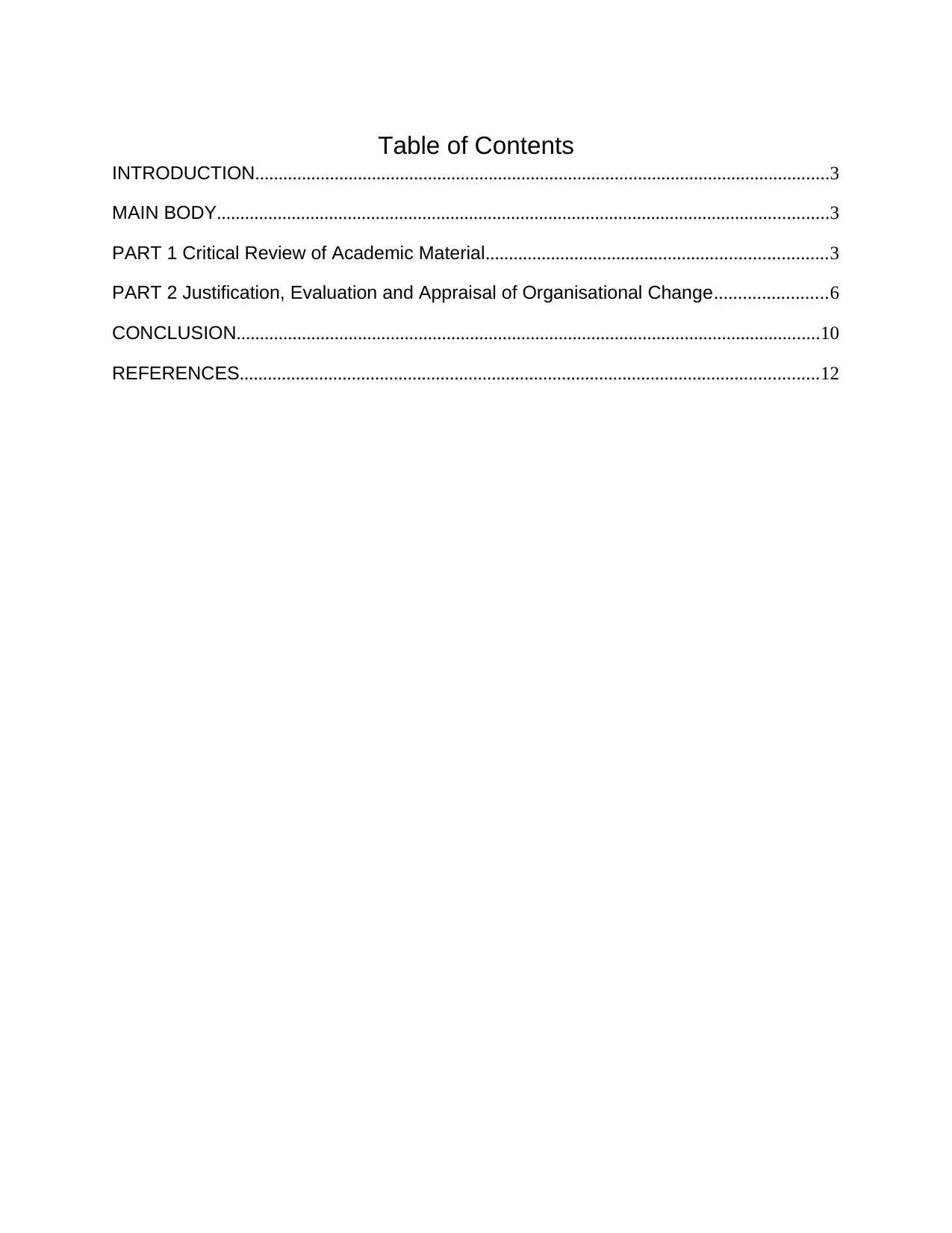
Table of Contents
INTRODUCTION...........................................................................................................................3
MAIN BODY...................................................................................................................................3
PART 1 Critical Review of Academic Material.........................................................................3
PART 2 Justification, Evaluation and Appraisal of Organisational Change........................6
CONCLUSION.............................................................................................................................10
REFERENCES............................................................................................................................12
INTRODUCTION...........................................................................................................................3
MAIN BODY...................................................................................................................................3
PART 1 Critical Review of Academic Material.........................................................................3
PART 2 Justification, Evaluation and Appraisal of Organisational Change........................6
CONCLUSION.............................................................................................................................10
REFERENCES............................................................................................................................12
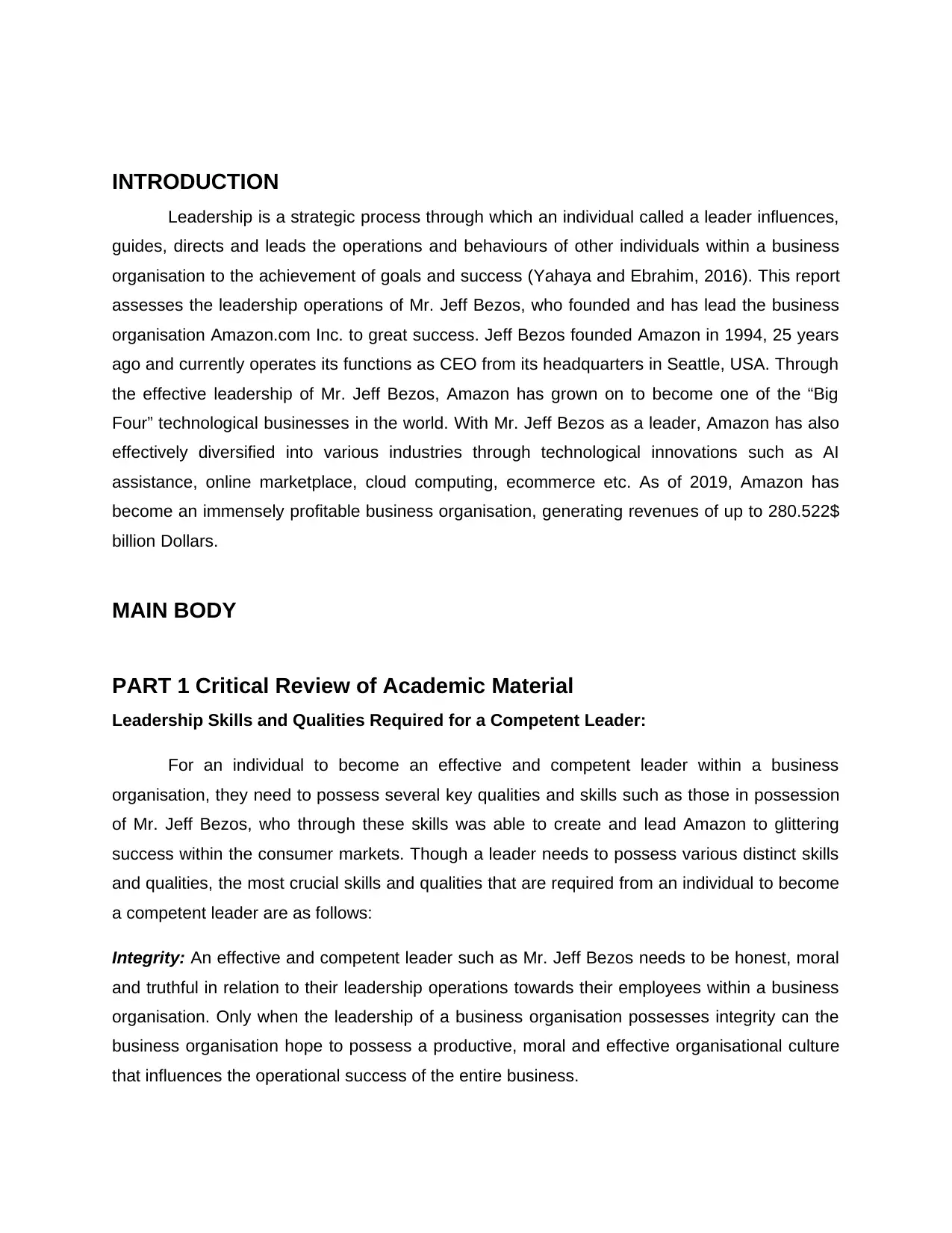
INTRODUCTION
Leadership is a strategic process through which an individual called a leader influences,
guides, directs and leads the operations and behaviours of other individuals within a business
organisation to the achievement of goals and success (Yahaya and Ebrahim, 2016). This report
assesses the leadership operations of Mr. Jeff Bezos, who founded and has lead the business
organisation Amazon.com Inc. to great success. Jeff Bezos founded Amazon in 1994, 25 years
ago and currently operates its functions as CEO from its headquarters in Seattle, USA. Through
the effective leadership of Mr. Jeff Bezos, Amazon has grown on to become one of the “Big
Four” technological businesses in the world. With Mr. Jeff Bezos as a leader, Amazon has also
effectively diversified into various industries through technological innovations such as AI
assistance, online marketplace, cloud computing, ecommerce etc. As of 2019, Amazon has
become an immensely profitable business organisation, generating revenues of up to 280.522$
billion Dollars.
MAIN BODY
PART 1 Critical Review of Academic Material
Leadership Skills and Qualities Required for a Competent Leader:
For an individual to become an effective and competent leader within a business
organisation, they need to possess several key qualities and skills such as those in possession
of Mr. Jeff Bezos, who through these skills was able to create and lead Amazon to glittering
success within the consumer markets. Though a leader needs to possess various distinct skills
and qualities, the most crucial skills and qualities that are required from an individual to become
a competent leader are as follows:
Integrity: An effective and competent leader such as Mr. Jeff Bezos needs to be honest, moral
and truthful in relation to their leadership operations towards their employees within a business
organisation. Only when the leadership of a business organisation possesses integrity can the
business organisation hope to possess a productive, moral and effective organisational culture
that influences the operational success of the entire business.
Leadership is a strategic process through which an individual called a leader influences,
guides, directs and leads the operations and behaviours of other individuals within a business
organisation to the achievement of goals and success (Yahaya and Ebrahim, 2016). This report
assesses the leadership operations of Mr. Jeff Bezos, who founded and has lead the business
organisation Amazon.com Inc. to great success. Jeff Bezos founded Amazon in 1994, 25 years
ago and currently operates its functions as CEO from its headquarters in Seattle, USA. Through
the effective leadership of Mr. Jeff Bezos, Amazon has grown on to become one of the “Big
Four” technological businesses in the world. With Mr. Jeff Bezos as a leader, Amazon has also
effectively diversified into various industries through technological innovations such as AI
assistance, online marketplace, cloud computing, ecommerce etc. As of 2019, Amazon has
become an immensely profitable business organisation, generating revenues of up to 280.522$
billion Dollars.
MAIN BODY
PART 1 Critical Review of Academic Material
Leadership Skills and Qualities Required for a Competent Leader:
For an individual to become an effective and competent leader within a business
organisation, they need to possess several key qualities and skills such as those in possession
of Mr. Jeff Bezos, who through these skills was able to create and lead Amazon to glittering
success within the consumer markets. Though a leader needs to possess various distinct skills
and qualities, the most crucial skills and qualities that are required from an individual to become
a competent leader are as follows:
Integrity: An effective and competent leader such as Mr. Jeff Bezos needs to be honest, moral
and truthful in relation to their leadership operations towards their employees within a business
organisation. Only when the leadership of a business organisation possesses integrity can the
business organisation hope to possess a productive, moral and effective organisational culture
that influences the operational success of the entire business.
⊘ This is a preview!⊘
Do you want full access?
Subscribe today to unlock all pages.

Trusted by 1+ million students worldwide
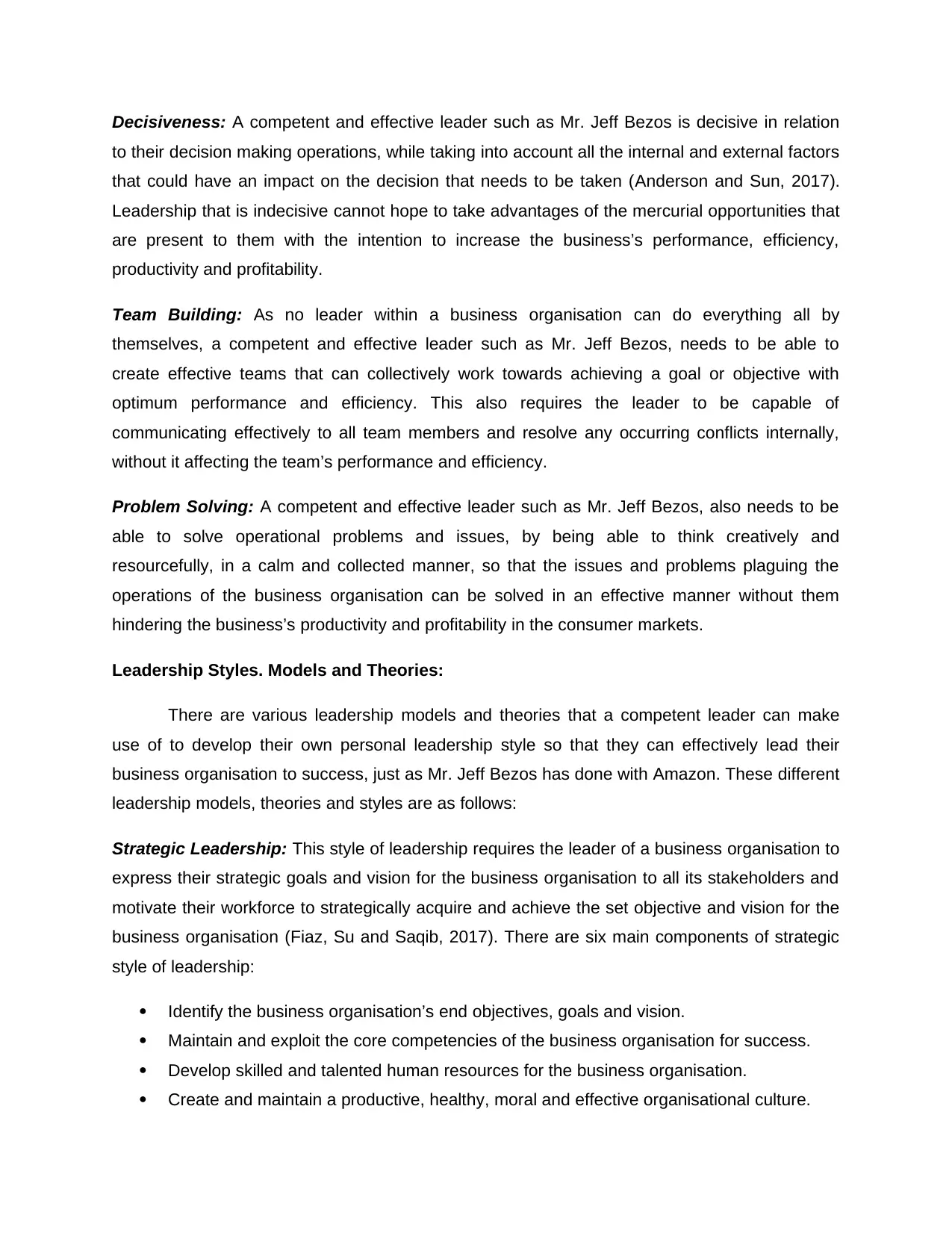
Decisiveness: A competent and effective leader such as Mr. Jeff Bezos is decisive in relation
to their decision making operations, while taking into account all the internal and external factors
that could have an impact on the decision that needs to be taken (Anderson and Sun, 2017).
Leadership that is indecisive cannot hope to take advantages of the mercurial opportunities that
are present to them with the intention to increase the business’s performance, efficiency,
productivity and profitability.
Team Building: As no leader within a business organisation can do everything all by
themselves, a competent and effective leader such as Mr. Jeff Bezos, needs to be able to
create effective teams that can collectively work towards achieving a goal or objective with
optimum performance and efficiency. This also requires the leader to be capable of
communicating effectively to all team members and resolve any occurring conflicts internally,
without it affecting the team’s performance and efficiency.
Problem Solving: A competent and effective leader such as Mr. Jeff Bezos, also needs to be
able to solve operational problems and issues, by being able to think creatively and
resourcefully, in a calm and collected manner, so that the issues and problems plaguing the
operations of the business organisation can be solved in an effective manner without them
hindering the business’s productivity and profitability in the consumer markets.
Leadership Styles. Models and Theories:
There are various leadership models and theories that a competent leader can make
use of to develop their own personal leadership style so that they can effectively lead their
business organisation to success, just as Mr. Jeff Bezos has done with Amazon. These different
leadership models, theories and styles are as follows:
Strategic Leadership: This style of leadership requires the leader of a business organisation to
express their strategic goals and vision for the business organisation to all its stakeholders and
motivate their workforce to strategically acquire and achieve the set objective and vision for the
business organisation (Fiaz, Su and Saqib, 2017). There are six main components of strategic
style of leadership:
Identify the business organisation’s end objectives, goals and vision.
Maintain and exploit the core competencies of the business organisation for success.
Develop skilled and talented human resources for the business organisation.
Create and maintain a productive, healthy, moral and effective organisational culture.
to their decision making operations, while taking into account all the internal and external factors
that could have an impact on the decision that needs to be taken (Anderson and Sun, 2017).
Leadership that is indecisive cannot hope to take advantages of the mercurial opportunities that
are present to them with the intention to increase the business’s performance, efficiency,
productivity and profitability.
Team Building: As no leader within a business organisation can do everything all by
themselves, a competent and effective leader such as Mr. Jeff Bezos, needs to be able to
create effective teams that can collectively work towards achieving a goal or objective with
optimum performance and efficiency. This also requires the leader to be capable of
communicating effectively to all team members and resolve any occurring conflicts internally,
without it affecting the team’s performance and efficiency.
Problem Solving: A competent and effective leader such as Mr. Jeff Bezos, also needs to be
able to solve operational problems and issues, by being able to think creatively and
resourcefully, in a calm and collected manner, so that the issues and problems plaguing the
operations of the business organisation can be solved in an effective manner without them
hindering the business’s productivity and profitability in the consumer markets.
Leadership Styles. Models and Theories:
There are various leadership models and theories that a competent leader can make
use of to develop their own personal leadership style so that they can effectively lead their
business organisation to success, just as Mr. Jeff Bezos has done with Amazon. These different
leadership models, theories and styles are as follows:
Strategic Leadership: This style of leadership requires the leader of a business organisation to
express their strategic goals and vision for the business organisation to all its stakeholders and
motivate their workforce to strategically acquire and achieve the set objective and vision for the
business organisation (Fiaz, Su and Saqib, 2017). There are six main components of strategic
style of leadership:
Identify the business organisation’s end objectives, goals and vision.
Maintain and exploit the core competencies of the business organisation for success.
Develop skilled and talented human resources for the business organisation.
Create and maintain a productive, healthy, moral and effective organisational culture.
Paraphrase This Document
Need a fresh take? Get an instant paraphrase of this document with our AI Paraphraser
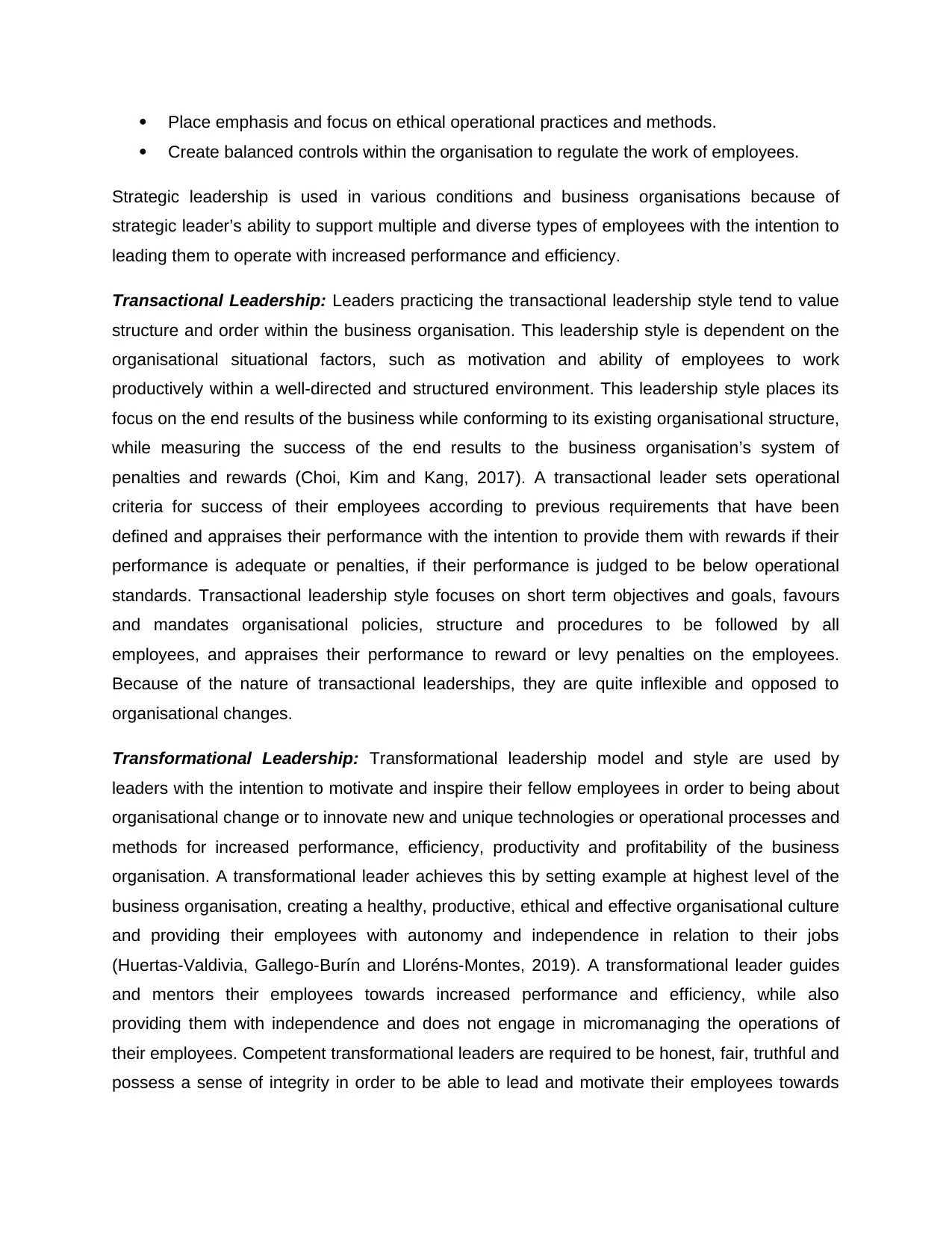
Place emphasis and focus on ethical operational practices and methods.
Create balanced controls within the organisation to regulate the work of employees.
Strategic leadership is used in various conditions and business organisations because of
strategic leader’s ability to support multiple and diverse types of employees with the intention to
leading them to operate with increased performance and efficiency.
Transactional Leadership: Leaders practicing the transactional leadership style tend to value
structure and order within the business organisation. This leadership style is dependent on the
organisational situational factors, such as motivation and ability of employees to work
productively within a well-directed and structured environment. This leadership style places its
focus on the end results of the business while conforming to its existing organisational structure,
while measuring the success of the end results to the business organisation’s system of
penalties and rewards (Choi, Kim and Kang, 2017). A transactional leader sets operational
criteria for success of their employees according to previous requirements that have been
defined and appraises their performance with the intention to provide them with rewards if their
performance is adequate or penalties, if their performance is judged to be below operational
standards. Transactional leadership style focuses on short term objectives and goals, favours
and mandates organisational policies, structure and procedures to be followed by all
employees, and appraises their performance to reward or levy penalties on the employees.
Because of the nature of transactional leaderships, they are quite inflexible and opposed to
organisational changes.
Transformational Leadership: Transformational leadership model and style are used by
leaders with the intention to motivate and inspire their fellow employees in order to being about
organisational change or to innovate new and unique technologies or operational processes and
methods for increased performance, efficiency, productivity and profitability of the business
organisation. A transformational leader achieves this by setting example at highest level of the
business organisation, creating a healthy, productive, ethical and effective organisational culture
and providing their employees with autonomy and independence in relation to their jobs
(Huertas-Valdivia, Gallego-Burín and Lloréns-Montes, 2019). A transformational leader guides
and mentors their employees towards increased performance and efficiency, while also
providing them with independence and does not engage in micromanaging the operations of
their employees. Competent transformational leaders are required to be honest, fair, truthful and
possess a sense of integrity in order to be able to lead and motivate their employees towards
Create balanced controls within the organisation to regulate the work of employees.
Strategic leadership is used in various conditions and business organisations because of
strategic leader’s ability to support multiple and diverse types of employees with the intention to
leading them to operate with increased performance and efficiency.
Transactional Leadership: Leaders practicing the transactional leadership style tend to value
structure and order within the business organisation. This leadership style is dependent on the
organisational situational factors, such as motivation and ability of employees to work
productively within a well-directed and structured environment. This leadership style places its
focus on the end results of the business while conforming to its existing organisational structure,
while measuring the success of the end results to the business organisation’s system of
penalties and rewards (Choi, Kim and Kang, 2017). A transactional leader sets operational
criteria for success of their employees according to previous requirements that have been
defined and appraises their performance with the intention to provide them with rewards if their
performance is adequate or penalties, if their performance is judged to be below operational
standards. Transactional leadership style focuses on short term objectives and goals, favours
and mandates organisational policies, structure and procedures to be followed by all
employees, and appraises their performance to reward or levy penalties on the employees.
Because of the nature of transactional leaderships, they are quite inflexible and opposed to
organisational changes.
Transformational Leadership: Transformational leadership model and style are used by
leaders with the intention to motivate and inspire their fellow employees in order to being about
organisational change or to innovate new and unique technologies or operational processes and
methods for increased performance, efficiency, productivity and profitability of the business
organisation. A transformational leader achieves this by setting example at highest level of the
business organisation, creating a healthy, productive, ethical and effective organisational culture
and providing their employees with autonomy and independence in relation to their jobs
(Huertas-Valdivia, Gallego-Burín and Lloréns-Montes, 2019). A transformational leader guides
and mentors their employees towards increased performance and efficiency, while also
providing them with independence and does not engage in micromanaging the operations of
their employees. Competent transformational leaders are required to be honest, fair, truthful and
possess a sense of integrity in order to be able to lead and motivate their employees towards
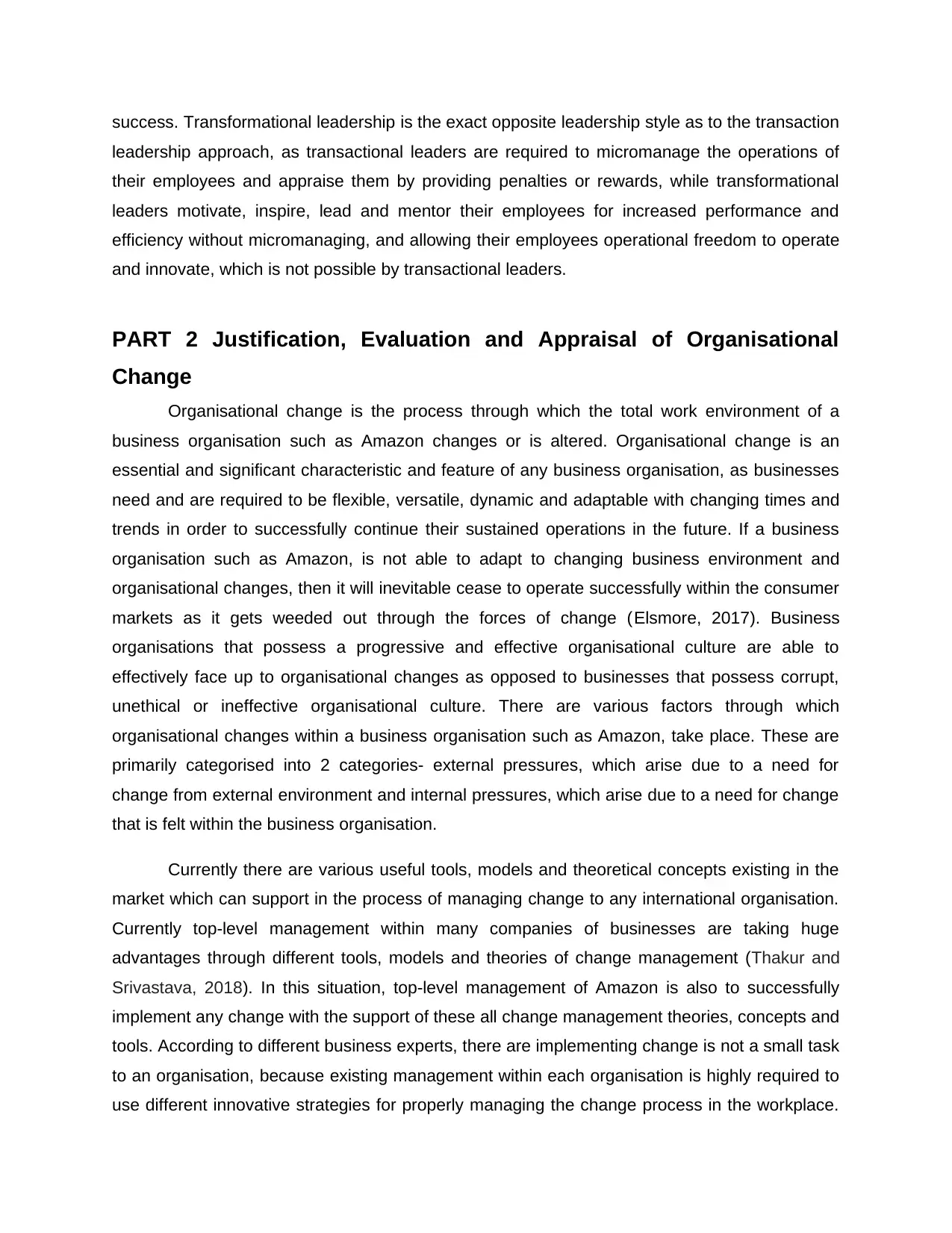
success. Transformational leadership is the exact opposite leadership style as to the transaction
leadership approach, as transactional leaders are required to micromanage the operations of
their employees and appraise them by providing penalties or rewards, while transformational
leaders motivate, inspire, lead and mentor their employees for increased performance and
efficiency without micromanaging, and allowing their employees operational freedom to operate
and innovate, which is not possible by transactional leaders.
PART 2 Justification, Evaluation and Appraisal of Organisational
Change
Organisational change is the process through which the total work environment of a
business organisation such as Amazon changes or is altered. Organisational change is an
essential and significant characteristic and feature of any business organisation, as businesses
need and are required to be flexible, versatile, dynamic and adaptable with changing times and
trends in order to successfully continue their sustained operations in the future. If a business
organisation such as Amazon, is not able to adapt to changing business environment and
organisational changes, then it will inevitable cease to operate successfully within the consumer
markets as it gets weeded out through the forces of change (Elsmore, 2017). Business
organisations that possess a progressive and effective organisational culture are able to
effectively face up to organisational changes as opposed to businesses that possess corrupt,
unethical or ineffective organisational culture. There are various factors through which
organisational changes within a business organisation such as Amazon, take place. These are
primarily categorised into 2 categories- external pressures, which arise due to a need for
change from external environment and internal pressures, which arise due to a need for change
that is felt within the business organisation.
Currently there are various useful tools, models and theoretical concepts existing in the
market which can support in the process of managing change to any international organisation.
Currently top-level management within many companies of businesses are taking huge
advantages through different tools, models and theories of change management (Thakur and
Srivastava, 2018). In this situation, top-level management of Amazon is also to successfully
implement any change with the support of these all change management theories, concepts and
tools. According to different business experts, there are implementing change is not a small task
to an organisation, because existing management within each organisation is highly required to
use different innovative strategies for properly managing the change process in the workplace.
leadership approach, as transactional leaders are required to micromanage the operations of
their employees and appraise them by providing penalties or rewards, while transformational
leaders motivate, inspire, lead and mentor their employees for increased performance and
efficiency without micromanaging, and allowing their employees operational freedom to operate
and innovate, which is not possible by transactional leaders.
PART 2 Justification, Evaluation and Appraisal of Organisational
Change
Organisational change is the process through which the total work environment of a
business organisation such as Amazon changes or is altered. Organisational change is an
essential and significant characteristic and feature of any business organisation, as businesses
need and are required to be flexible, versatile, dynamic and adaptable with changing times and
trends in order to successfully continue their sustained operations in the future. If a business
organisation such as Amazon, is not able to adapt to changing business environment and
organisational changes, then it will inevitable cease to operate successfully within the consumer
markets as it gets weeded out through the forces of change (Elsmore, 2017). Business
organisations that possess a progressive and effective organisational culture are able to
effectively face up to organisational changes as opposed to businesses that possess corrupt,
unethical or ineffective organisational culture. There are various factors through which
organisational changes within a business organisation such as Amazon, take place. These are
primarily categorised into 2 categories- external pressures, which arise due to a need for
change from external environment and internal pressures, which arise due to a need for change
that is felt within the business organisation.
Currently there are various useful tools, models and theoretical concepts existing in the
market which can support in the process of managing change to any international organisation.
Currently top-level management within many companies of businesses are taking huge
advantages through different tools, models and theories of change management (Thakur and
Srivastava, 2018). In this situation, top-level management of Amazon is also to successfully
implement any change with the support of these all change management theories, concepts and
tools. According to different business experts, there are implementing change is not a small task
to an organisation, because existing management within each organisation is highly required to
use different innovative strategies for properly managing the change process in the workplace.
⊘ This is a preview!⊘
Do you want full access?
Subscribe today to unlock all pages.

Trusted by 1+ million students worldwide
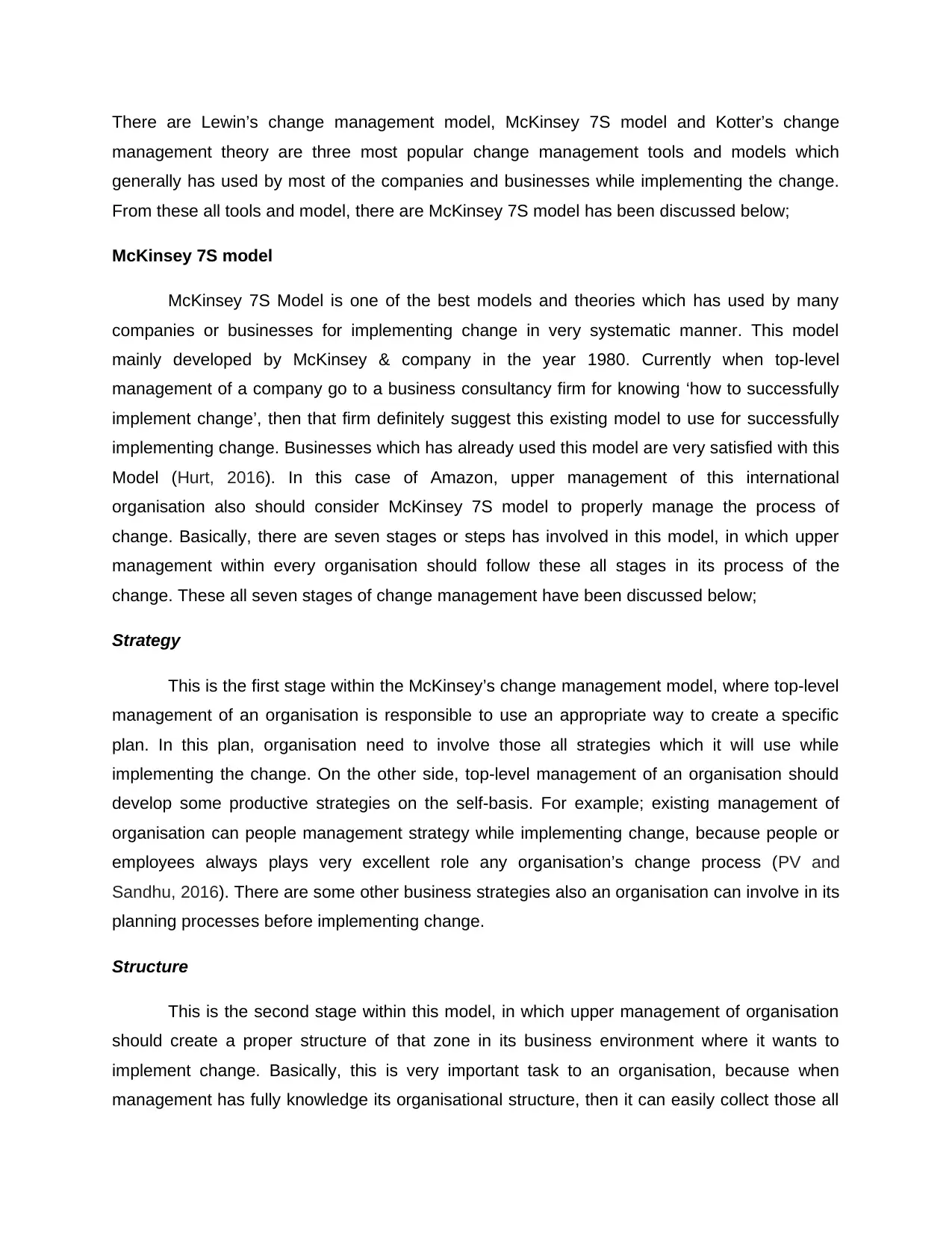
There are Lewin’s change management model, McKinsey 7S model and Kotter’s change
management theory are three most popular change management tools and models which
generally has used by most of the companies and businesses while implementing the change.
From these all tools and model, there are McKinsey 7S model has been discussed below;
McKinsey 7S model
McKinsey 7S Model is one of the best models and theories which has used by many
companies or businesses for implementing change in very systematic manner. This model
mainly developed by McKinsey & company in the year 1980. Currently when top-level
management of a company go to a business consultancy firm for knowing ‘how to successfully
implement change’, then that firm definitely suggest this existing model to use for successfully
implementing change. Businesses which has already used this model are very satisfied with this
Model (Hurt, 2016). In this case of Amazon, upper management of this international
organisation also should consider McKinsey 7S model to properly manage the process of
change. Basically, there are seven stages or steps has involved in this model, in which upper
management within every organisation should follow these all stages in its process of the
change. These all seven stages of change management have been discussed below;
Strategy
This is the first stage within the McKinsey’s change management model, where top-level
management of an organisation is responsible to use an appropriate way to create a specific
plan. In this plan, organisation need to involve those all strategies which it will use while
implementing the change. On the other side, top-level management of an organisation should
develop some productive strategies on the self-basis. For example; existing management of
organisation can people management strategy while implementing change, because people or
employees always plays very excellent role any organisation’s change process (PV and
Sandhu, 2016). There are some other business strategies also an organisation can involve in its
planning processes before implementing change.
Structure
This is the second stage within this model, in which upper management of organisation
should create a proper structure of that zone in its business environment where it wants to
implement change. Basically, this is very important task to an organisation, because when
management has fully knowledge its organisational structure, then it can easily collect those all
management theory are three most popular change management tools and models which
generally has used by most of the companies and businesses while implementing the change.
From these all tools and model, there are McKinsey 7S model has been discussed below;
McKinsey 7S model
McKinsey 7S Model is one of the best models and theories which has used by many
companies or businesses for implementing change in very systematic manner. This model
mainly developed by McKinsey & company in the year 1980. Currently when top-level
management of a company go to a business consultancy firm for knowing ‘how to successfully
implement change’, then that firm definitely suggest this existing model to use for successfully
implementing change. Businesses which has already used this model are very satisfied with this
Model (Hurt, 2016). In this case of Amazon, upper management of this international
organisation also should consider McKinsey 7S model to properly manage the process of
change. Basically, there are seven stages or steps has involved in this model, in which upper
management within every organisation should follow these all stages in its process of the
change. These all seven stages of change management have been discussed below;
Strategy
This is the first stage within the McKinsey’s change management model, where top-level
management of an organisation is responsible to use an appropriate way to create a specific
plan. In this plan, organisation need to involve those all strategies which it will use while
implementing the change. On the other side, top-level management of an organisation should
develop some productive strategies on the self-basis. For example; existing management of
organisation can people management strategy while implementing change, because people or
employees always plays very excellent role any organisation’s change process (PV and
Sandhu, 2016). There are some other business strategies also an organisation can involve in its
planning processes before implementing change.
Structure
This is the second stage within this model, in which upper management of organisation
should create a proper structure of that zone in its business environment where it wants to
implement change. Basically, this is very important task to an organisation, because when
management has fully knowledge its organisational structure, then it can easily collect those all
Paraphrase This Document
Need a fresh take? Get an instant paraphrase of this document with our AI Paraphraser
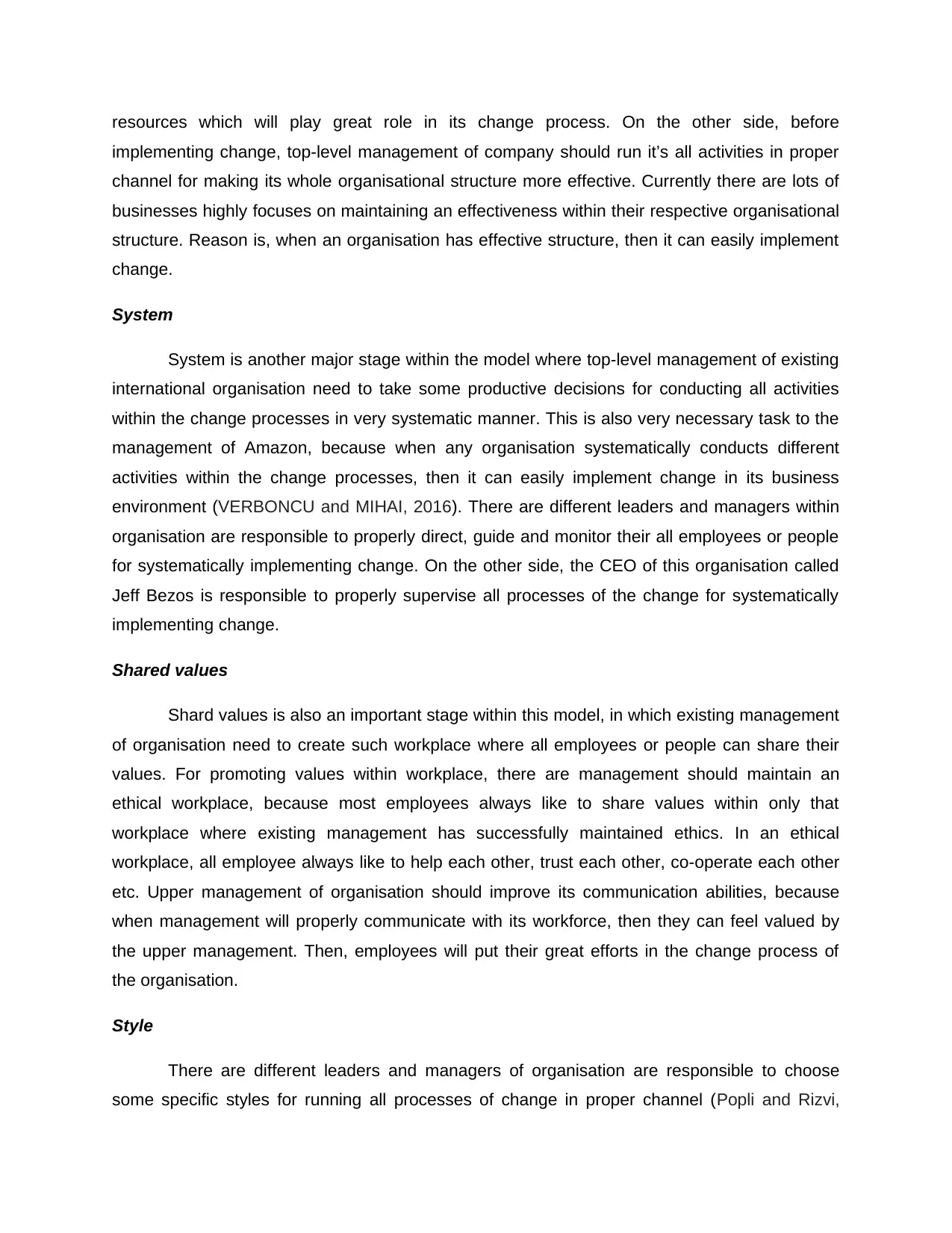
resources which will play great role in its change process. On the other side, before
implementing change, top-level management of company should run it’s all activities in proper
channel for making its whole organisational structure more effective. Currently there are lots of
businesses highly focuses on maintaining an effectiveness within their respective organisational
structure. Reason is, when an organisation has effective structure, then it can easily implement
change.
System
System is another major stage within the model where top-level management of existing
international organisation need to take some productive decisions for conducting all activities
within the change processes in very systematic manner. This is also very necessary task to the
management of Amazon, because when any organisation systematically conducts different
activities within the change processes, then it can easily implement change in its business
environment (VERBONCU and MIHAI, 2016). There are different leaders and managers within
organisation are responsible to properly direct, guide and monitor their all employees or people
for systematically implementing change. On the other side, the CEO of this organisation called
Jeff Bezos is responsible to properly supervise all processes of the change for systematically
implementing change.
Shared values
Shard values is also an important stage within this model, in which existing management
of organisation need to create such workplace where all employees or people can share their
values. For promoting values within workplace, there are management should maintain an
ethical workplace, because most employees always like to share values within only that
workplace where existing management has successfully maintained ethics. In an ethical
workplace, all employee always like to help each other, trust each other, co-operate each other
etc. Upper management of organisation should improve its communication abilities, because
when management will properly communicate with its workforce, then they can feel valued by
the upper management. Then, employees will put their great efforts in the change process of
the organisation.
Style
There are different leaders and managers of organisation are responsible to choose
some specific styles for running all processes of change in proper channel (Popli and Rizvi,
implementing change, top-level management of company should run it’s all activities in proper
channel for making its whole organisational structure more effective. Currently there are lots of
businesses highly focuses on maintaining an effectiveness within their respective organisational
structure. Reason is, when an organisation has effective structure, then it can easily implement
change.
System
System is another major stage within the model where top-level management of existing
international organisation need to take some productive decisions for conducting all activities
within the change processes in very systematic manner. This is also very necessary task to the
management of Amazon, because when any organisation systematically conducts different
activities within the change processes, then it can easily implement change in its business
environment (VERBONCU and MIHAI, 2016). There are different leaders and managers within
organisation are responsible to properly direct, guide and monitor their all employees or people
for systematically implementing change. On the other side, the CEO of this organisation called
Jeff Bezos is responsible to properly supervise all processes of the change for systematically
implementing change.
Shared values
Shard values is also an important stage within this model, in which existing management
of organisation need to create such workplace where all employees or people can share their
values. For promoting values within workplace, there are management should maintain an
ethical workplace, because most employees always like to share values within only that
workplace where existing management has successfully maintained ethics. In an ethical
workplace, all employee always like to help each other, trust each other, co-operate each other
etc. Upper management of organisation should improve its communication abilities, because
when management will properly communicate with its workforce, then they can feel valued by
the upper management. Then, employees will put their great efforts in the change process of
the organisation.
Style
There are different leaders and managers of organisation are responsible to choose
some specific styles for running all processes of change in proper channel (Popli and Rizvi,
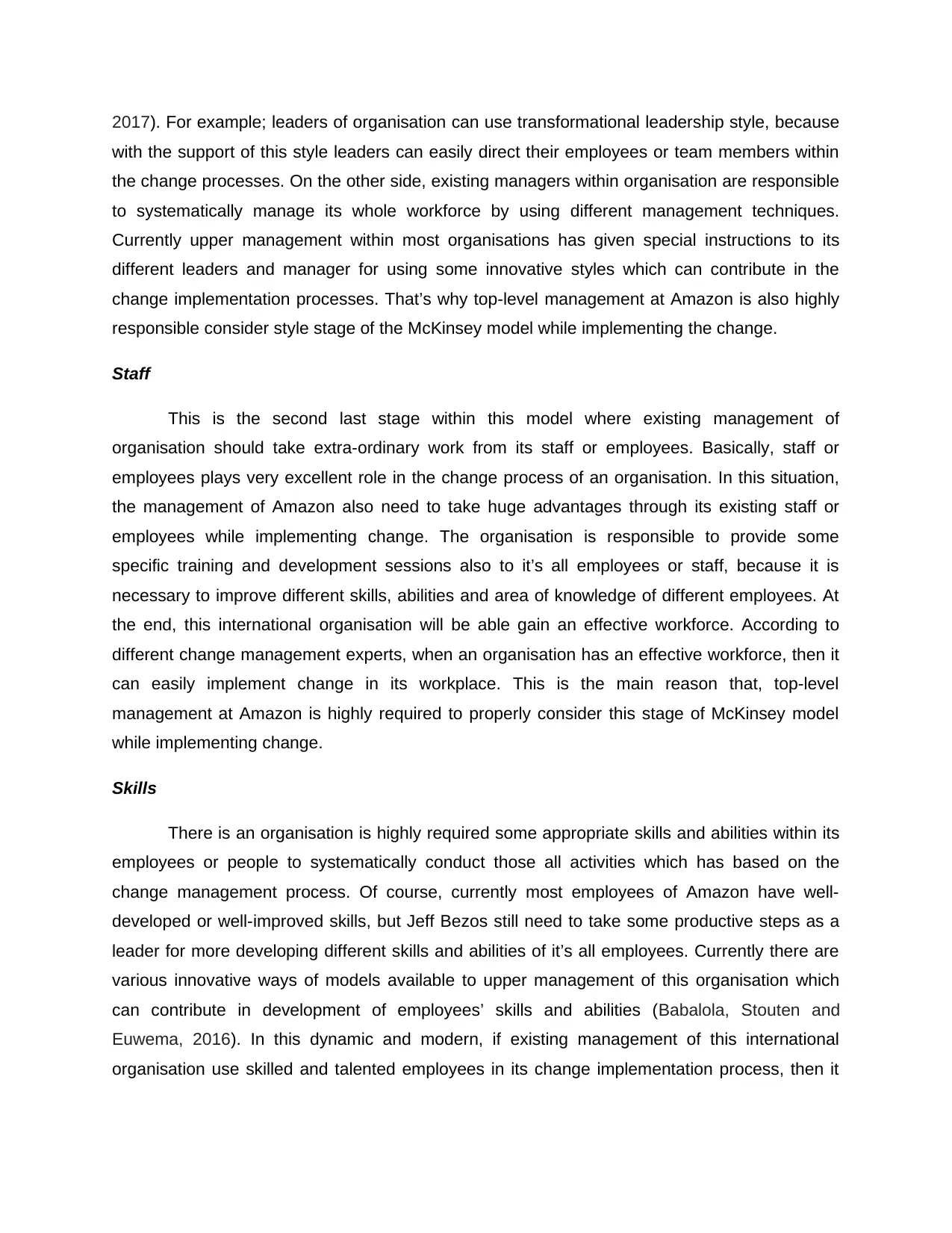
2017). For example; leaders of organisation can use transformational leadership style, because
with the support of this style leaders can easily direct their employees or team members within
the change processes. On the other side, existing managers within organisation are responsible
to systematically manage its whole workforce by using different management techniques.
Currently upper management within most organisations has given special instructions to its
different leaders and manager for using some innovative styles which can contribute in the
change implementation processes. That’s why top-level management at Amazon is also highly
responsible consider style stage of the McKinsey model while implementing the change.
Staff
This is the second last stage within this model where existing management of
organisation should take extra-ordinary work from its staff or employees. Basically, staff or
employees plays very excellent role in the change process of an organisation. In this situation,
the management of Amazon also need to take huge advantages through its existing staff or
employees while implementing change. The organisation is responsible to provide some
specific training and development sessions also to it’s all employees or staff, because it is
necessary to improve different skills, abilities and area of knowledge of different employees. At
the end, this international organisation will be able gain an effective workforce. According to
different change management experts, when an organisation has an effective workforce, then it
can easily implement change in its workplace. This is the main reason that, top-level
management at Amazon is highly required to properly consider this stage of McKinsey model
while implementing change.
Skills
There is an organisation is highly required some appropriate skills and abilities within its
employees or people to systematically conduct those all activities which has based on the
change management process. Of course, currently most employees of Amazon have well-
developed or well-improved skills, but Jeff Bezos still need to take some productive steps as a
leader for more developing different skills and abilities of it’s all employees. Currently there are
various innovative ways of models available to upper management of this organisation which
can contribute in development of employees’ skills and abilities (Babalola, Stouten and
Euwema, 2016). In this dynamic and modern, if existing management of this international
organisation use skilled and talented employees in its change implementation process, then it
with the support of this style leaders can easily direct their employees or team members within
the change processes. On the other side, existing managers within organisation are responsible
to systematically manage its whole workforce by using different management techniques.
Currently upper management within most organisations has given special instructions to its
different leaders and manager for using some innovative styles which can contribute in the
change implementation processes. That’s why top-level management at Amazon is also highly
responsible consider style stage of the McKinsey model while implementing the change.
Staff
This is the second last stage within this model where existing management of
organisation should take extra-ordinary work from its staff or employees. Basically, staff or
employees plays very excellent role in the change process of an organisation. In this situation,
the management of Amazon also need to take huge advantages through its existing staff or
employees while implementing change. The organisation is responsible to provide some
specific training and development sessions also to it’s all employees or staff, because it is
necessary to improve different skills, abilities and area of knowledge of different employees. At
the end, this international organisation will be able gain an effective workforce. According to
different change management experts, when an organisation has an effective workforce, then it
can easily implement change in its workplace. This is the main reason that, top-level
management at Amazon is highly required to properly consider this stage of McKinsey model
while implementing change.
Skills
There is an organisation is highly required some appropriate skills and abilities within its
employees or people to systematically conduct those all activities which has based on the
change management process. Of course, currently most employees of Amazon have well-
developed or well-improved skills, but Jeff Bezos still need to take some productive steps as a
leader for more developing different skills and abilities of it’s all employees. Currently there are
various innovative ways of models available to upper management of this organisation which
can contribute in development of employees’ skills and abilities (Babalola, Stouten and
Euwema, 2016). In this dynamic and modern, if existing management of this international
organisation use skilled and talented employees in its change implementation process, then it
⊘ This is a preview!⊘
Do you want full access?
Subscribe today to unlock all pages.

Trusted by 1+ million students worldwide

can successfully implement the decided change. That’s why this stage of McKinsey is to
necessary to the organisation.
These all are some major stages of steps within the McKinsey model of change
management which top-level management of Amazon is highly required to consider in its
process of managing the change. If management properly consider these all stages while
implementing change, then it will be definitely succeeded in implementing change. This is the
main reason that, McKinsey is very useful model of change management for an international
organisation.
In change implementation process of an organisation, leader behaviours aspect also
plays very excellent role, because without an effective leadership no organisation can
implement change (Graham, 2016). In this situation, top-level management of an organisation
should take some proactive steps for making its leadership aspect more and more effective. For
example; currently Amazon’s CEO Jeff Bezos is an effective leader as well, because most
employees of this international organisation like to work under command Mr. Bezos. That’s why
Amazon can easily implement change in its business environment. Basically, an effective leader
always like to take creates such environment within a workplace, where all employees, staff or
people like to work productively (Cegarra-Navarro, Soto-Acosta and Wensley, 2016). On the
other side, ab effective leader always behaves with it’s all employees or team members in very
proper manner. There are leaders within different organisations are responsible to ethically
consider organisational dynamics, culture and power in the change management programmes.
This factor is too necessary for implementing change systematically.
CONCLUSION
Based on the findings of the report, it can be concluded that a skilled, competent leadership
is essential for the optimum productivity, profitability and overall success of any business
organisation in the world. This report evaluates the skills and qualities required for an individual
ton become a competent leader. The report also assesses various leadership styles, theories
and models which leaders can make use of to lead their businesses to success. Then the report
critically evaluates the concept and impact of organisational change and transformation in
business organisations. Further the report applies range of models, theories and tools to
process how organisational change is managed within a business organisation. The report also
evaluates the emotional impact of organisational change and changes in leadership behaviour
necessary to the organisation.
These all are some major stages of steps within the McKinsey model of change
management which top-level management of Amazon is highly required to consider in its
process of managing the change. If management properly consider these all stages while
implementing change, then it will be definitely succeeded in implementing change. This is the
main reason that, McKinsey is very useful model of change management for an international
organisation.
In change implementation process of an organisation, leader behaviours aspect also
plays very excellent role, because without an effective leadership no organisation can
implement change (Graham, 2016). In this situation, top-level management of an organisation
should take some proactive steps for making its leadership aspect more and more effective. For
example; currently Amazon’s CEO Jeff Bezos is an effective leader as well, because most
employees of this international organisation like to work under command Mr. Bezos. That’s why
Amazon can easily implement change in its business environment. Basically, an effective leader
always like to take creates such environment within a workplace, where all employees, staff or
people like to work productively (Cegarra-Navarro, Soto-Acosta and Wensley, 2016). On the
other side, ab effective leader always behaves with it’s all employees or team members in very
proper manner. There are leaders within different organisations are responsible to ethically
consider organisational dynamics, culture and power in the change management programmes.
This factor is too necessary for implementing change systematically.
CONCLUSION
Based on the findings of the report, it can be concluded that a skilled, competent leadership
is essential for the optimum productivity, profitability and overall success of any business
organisation in the world. This report evaluates the skills and qualities required for an individual
ton become a competent leader. The report also assesses various leadership styles, theories
and models which leaders can make use of to lead their businesses to success. Then the report
critically evaluates the concept and impact of organisational change and transformation in
business organisations. Further the report applies range of models, theories and tools to
process how organisational change is managed within a business organisation. The report also
evaluates the emotional impact of organisational change and changes in leadership behaviour
Paraphrase This Document
Need a fresh take? Get an instant paraphrase of this document with our AI Paraphraser
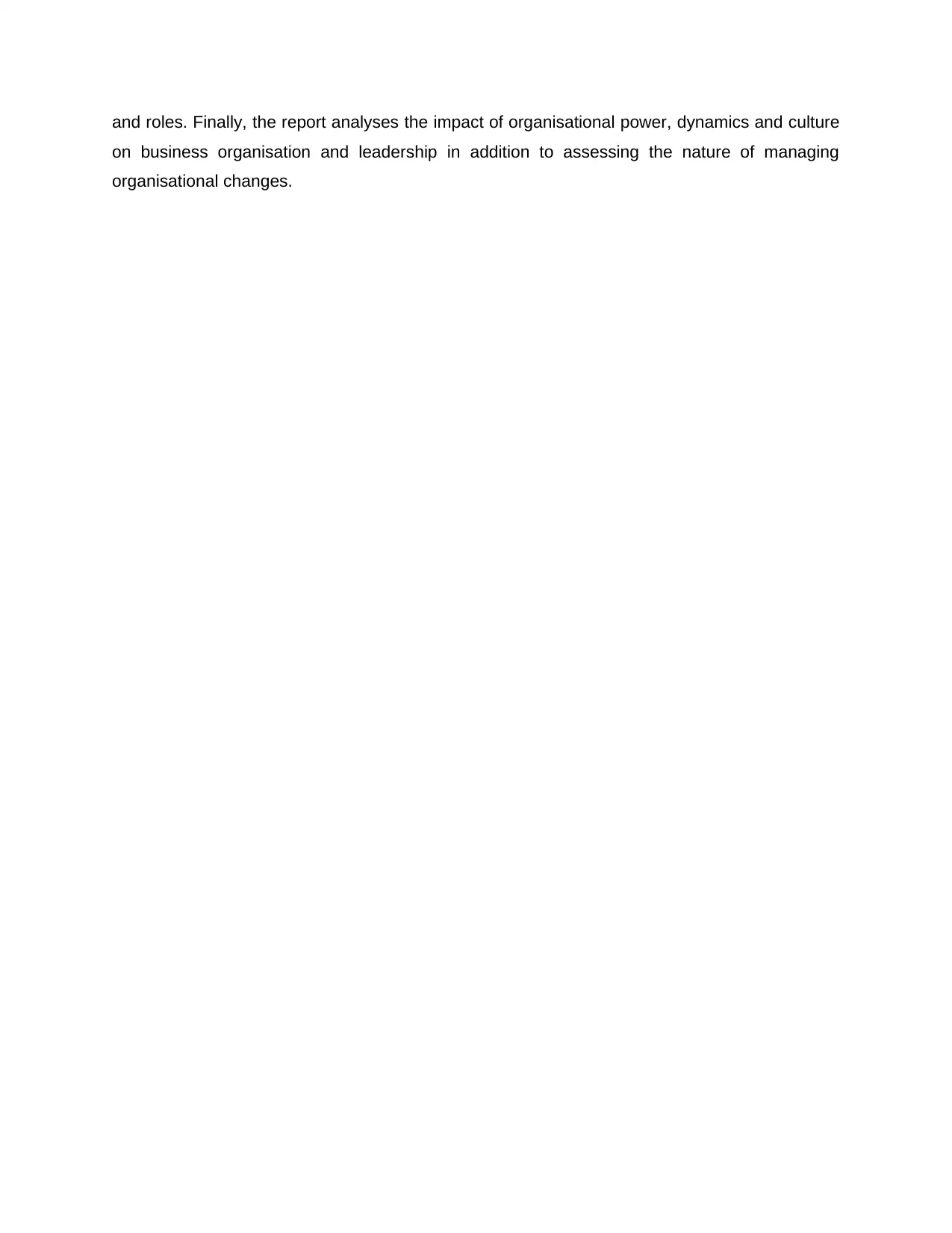
and roles. Finally, the report analyses the impact of organisational power, dynamics and culture
on business organisation and leadership in addition to assessing the nature of managing
organisational changes.
on business organisation and leadership in addition to assessing the nature of managing
organisational changes.
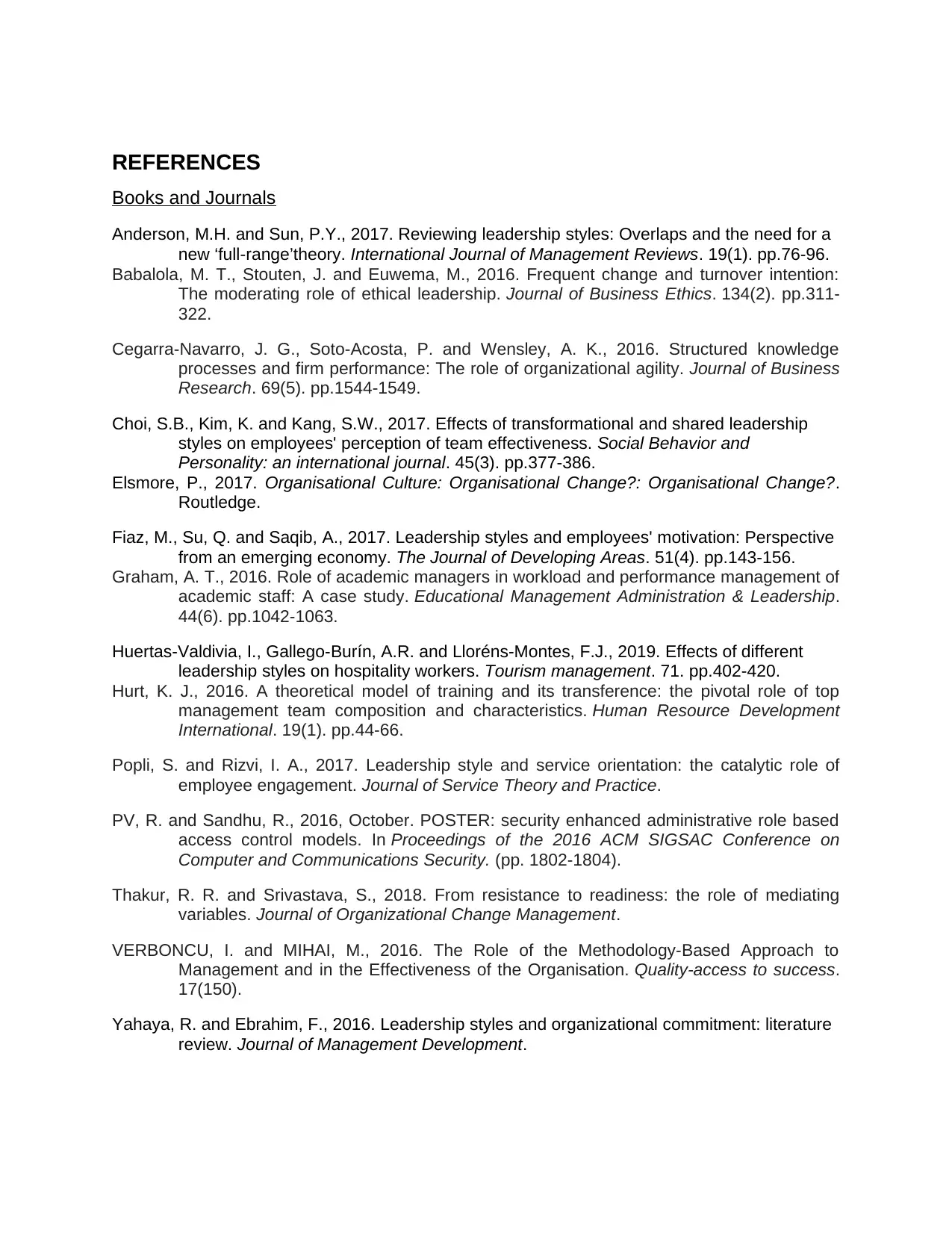
REFERENCES
Books and Journals
Anderson, M.H. and Sun, P.Y., 2017. Reviewing leadership styles: Overlaps and the need for a
new ‘full‐range’theory. International Journal of Management Reviews. 19(1). pp.76-96.
Babalola, M. T., Stouten, J. and Euwema, M., 2016. Frequent change and turnover intention:
The moderating role of ethical leadership. Journal of Business Ethics. 134(2). pp.311-
322.
Cegarra-Navarro, J. G., Soto-Acosta, P. and Wensley, A. K., 2016. Structured knowledge
processes and firm performance: The role of organizational agility. Journal of Business
Research. 69(5). pp.1544-1549.
Choi, S.B., Kim, K. and Kang, S.W., 2017. Effects of transformational and shared leadership
styles on employees' perception of team effectiveness. Social Behavior and
Personality: an international journal. 45(3). pp.377-386.
Elsmore, P., 2017. Organisational Culture: Organisational Change?: Organisational Change?.
Routledge.
Fiaz, M., Su, Q. and Saqib, A., 2017. Leadership styles and employees' motivation: Perspective
from an emerging economy. The Journal of Developing Areas. 51(4). pp.143-156.
Graham, A. T., 2016. Role of academic managers in workload and performance management of
academic staff: A case study. Educational Management Administration & Leadership.
44(6). pp.1042-1063.
Huertas-Valdivia, I., Gallego-Burín, A.R. and Lloréns-Montes, F.J., 2019. Effects of different
leadership styles on hospitality workers. Tourism management. 71. pp.402-420.
Hurt, K. J., 2016. A theoretical model of training and its transference: the pivotal role of top
management team composition and characteristics. Human Resource Development
International. 19(1). pp.44-66.
Popli, S. and Rizvi, I. A., 2017. Leadership style and service orientation: the catalytic role of
employee engagement. Journal of Service Theory and Practice.
PV, R. and Sandhu, R., 2016, October. POSTER: security enhanced administrative role based
access control models. In Proceedings of the 2016 ACM SIGSAC Conference on
Computer and Communications Security. (pp. 1802-1804).
Thakur, R. R. and Srivastava, S., 2018. From resistance to readiness: the role of mediating
variables. Journal of Organizational Change Management.
VERBONCU, I. and MIHAI, M., 2016. The Role of the Methodology-Based Approach to
Management and in the Effectiveness of the Organisation. Quality-access to success.
17(150).
Yahaya, R. and Ebrahim, F., 2016. Leadership styles and organizational commitment: literature
review. Journal of Management Development.
Books and Journals
Anderson, M.H. and Sun, P.Y., 2017. Reviewing leadership styles: Overlaps and the need for a
new ‘full‐range’theory. International Journal of Management Reviews. 19(1). pp.76-96.
Babalola, M. T., Stouten, J. and Euwema, M., 2016. Frequent change and turnover intention:
The moderating role of ethical leadership. Journal of Business Ethics. 134(2). pp.311-
322.
Cegarra-Navarro, J. G., Soto-Acosta, P. and Wensley, A. K., 2016. Structured knowledge
processes and firm performance: The role of organizational agility. Journal of Business
Research. 69(5). pp.1544-1549.
Choi, S.B., Kim, K. and Kang, S.W., 2017. Effects of transformational and shared leadership
styles on employees' perception of team effectiveness. Social Behavior and
Personality: an international journal. 45(3). pp.377-386.
Elsmore, P., 2017. Organisational Culture: Organisational Change?: Organisational Change?.
Routledge.
Fiaz, M., Su, Q. and Saqib, A., 2017. Leadership styles and employees' motivation: Perspective
from an emerging economy. The Journal of Developing Areas. 51(4). pp.143-156.
Graham, A. T., 2016. Role of academic managers in workload and performance management of
academic staff: A case study. Educational Management Administration & Leadership.
44(6). pp.1042-1063.
Huertas-Valdivia, I., Gallego-Burín, A.R. and Lloréns-Montes, F.J., 2019. Effects of different
leadership styles on hospitality workers. Tourism management. 71. pp.402-420.
Hurt, K. J., 2016. A theoretical model of training and its transference: the pivotal role of top
management team composition and characteristics. Human Resource Development
International. 19(1). pp.44-66.
Popli, S. and Rizvi, I. A., 2017. Leadership style and service orientation: the catalytic role of
employee engagement. Journal of Service Theory and Practice.
PV, R. and Sandhu, R., 2016, October. POSTER: security enhanced administrative role based
access control models. In Proceedings of the 2016 ACM SIGSAC Conference on
Computer and Communications Security. (pp. 1802-1804).
Thakur, R. R. and Srivastava, S., 2018. From resistance to readiness: the role of mediating
variables. Journal of Organizational Change Management.
VERBONCU, I. and MIHAI, M., 2016. The Role of the Methodology-Based Approach to
Management and in the Effectiveness of the Organisation. Quality-access to success.
17(150).
Yahaya, R. and Ebrahim, F., 2016. Leadership styles and organizational commitment: literature
review. Journal of Management Development.
⊘ This is a preview!⊘
Do you want full access?
Subscribe today to unlock all pages.

Trusted by 1+ million students worldwide
1 out of 12
Related Documents
Your All-in-One AI-Powered Toolkit for Academic Success.
+13062052269
info@desklib.com
Available 24*7 on WhatsApp / Email
![[object Object]](/_next/static/media/star-bottom.7253800d.svg)
Unlock your academic potential
Copyright © 2020–2025 A2Z Services. All Rights Reserved. Developed and managed by ZUCOL.




